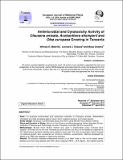| dc.description.abstract | Aims: To evaluate antimicrobial and cytotoxicity activities of Clausena anisata, Acokanthera shemperii and Olea europaea against seven Gram negative bacteria and fungal species.
Study Design: Bioassay of antimicrobial assay was done using 96-well micro-dilution method.
Place and Duration of Study: School of Life Science and Bioengineering, Nelson Mandela African Institution of Science and Technology, Arusha, Tanzania, from April 2014 to June 2014.
Methodology: 96-well micro dilution method was used in antimicrobial assay. Extracts were loaded in the wells of the first row, followed by serial dilution and 50 μl of the bacterial suspensions (0.5 MacFarland standard turbidity) were added in each well. The first concentration which showed no bacterial growth was considered as minimum inhibition concentration. Method developed by Meyer et al 1982 was adopted in cytotoxicity activities.
Results: All extracts indicated antibacterial activity on at least three to five of the tested seven bacteria and two fungi species with MIC value ranging 0.7812 - 12.5 mg/mL. The highest activity was demonstrated by Olea europaea leaf methanolic, Acokanthera shemperii stem bark and Clausena anisata twigs ethyl acetate extracts with MIC value of 0.7812 mg/mL against Pseudomonas aeruginosa while the same MIC value was exhibited by Olea europaea stem bark methanol against Proteus mirabilis. However the Olea europaea root methanolic extract inhibited the growth of Pseudomonas aeruginosa and Salmonella kisarawe with MIC value of 0.7812 mg/mL. Olea europaea leaf methanolic and stem bark methanolic which demonstrated high antimicrobial activity were non toxic against brine shrimp larvae with LC50 value of 369.8272 and 226.1566 µg/mL, while Clausena anisata twigs ethyl acetate, Acokanthera shemperii stem bark ethyl acetate and Olea europaea root methanolic extracts were toxic with LC50 value of 6.21276, 67.4179 and 92.3089 µg/mL respectively.
Conclusion: This study has unveiled antimicrobial and cytotoxicity properties of Clausena anisata, Acokanthera shemperii and Olea europaea. | en_US |

